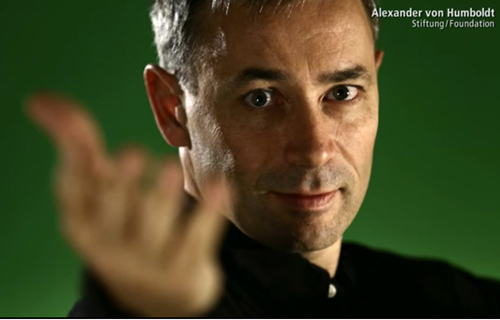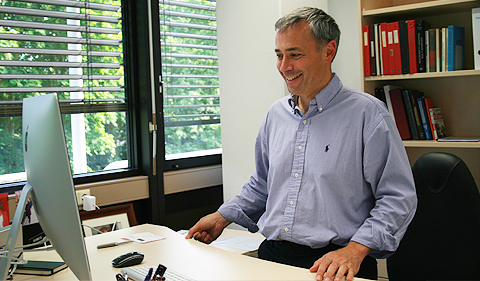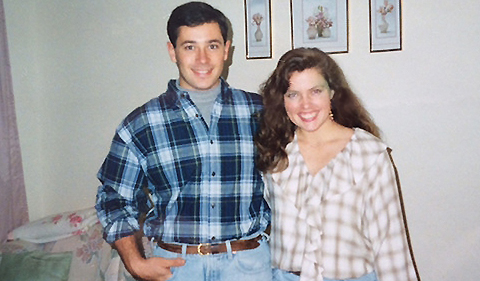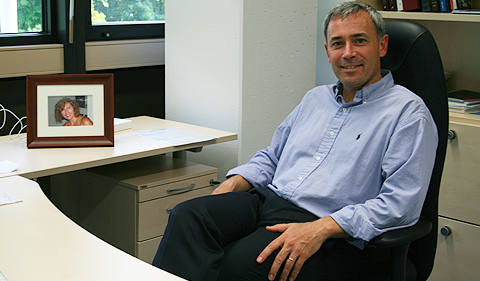By Jean Andrews
Physics & Astronomy
While in Mainz, Germany, last spring, Jean Andrews, a special projects assistant in the Department of Physics and Astronomy, paid a visit to the Johannes Gutenberg University where she interviewed theoretical physicist and Ohio University alum Dr. Jairo Sinova ’94B.S. HTC Physics.
The newly appointed Alexander von Humboldt Professor, Sinova is a condensed matter theoretician who specializes in spintronics, an emerging field involving the detection and manipulation of electron spin at the nanoscale level. He received the prestigious European Research Council (ERC) Synergy Grant to carry out spintronics research together with other European partners. He founded a new center in Mainz, the Spin Phenomena Interdisciplinary Center (SPICE).
Before moving to Mainz, Sinova was professor of physics at Texas A&M. A leading specialist in the area of theoretical solid-state physics and a pioneer in the theory of nanoscale magnetic materials, he is widely admired for his theoretical and experimental work related to the spin Hall effect.
His research has been published in top journals, such as Science, Nature Physics and Physical Review Letters, and highlighted in Physics Today. He has served as a reviewer for the National Science Foundation as well as several top physics journals, and he organized the first international conference on spin Hall effect in South Korea (2005). His many awards include an NSF Career Award (2006), a Research Corporation for Science Advancement Cottrell Scholar Award (2006) and a Texas A&M Association of Former Students College-Level Distinguished Achievement Award for Teaching (2008).
The ERC awards Synergy grants to enable outstanding scientists to work together on trailblazing projects. In order to receive one, each of the participating researchers needs to be among the best in his or her specific field and have enormous innovative potential.
Sinova’s Synergy team includes Henning Sirringhaus of the University of Cambridge as the group coordinator, Jörg Wunderlich of Hitachi Europe Limited and the Institute of Physics of the Academy of Sciences of the Czech Republic, and Iain McCulloch of the Imperial College of Science, Technology and Medicine in London.
They are developing new spintronics concepts. In the field of spintronics, the intrinsic angular momentum of electrons is exploited rather than their electrical charge as in the case of electronic silicon chips. The research team hopes that by combining principles of inorganic spintronics with organic materials they will achieve better results than if they used purely inorganic systems. The advantages of using polymers include the flexibility of the material, control over the physical properties, and the fact that they are relatively easy to produce. Within the joint research project, Sinova is responsible for theory and simulations.
This work is important because the computer industry needs fundamentally new technologies. Traditional silicon chips have reached their limits. Millions of transistors concentrated on tiny surfaces use too much power. New methods to store power, reduce the heat generated, and increase computing speed are needed. Spintronics may help researchers discover new physical phenomena and lead to the production of materials with new properties.
The ERC Synergy grant and the associated tasks represent a supplementary element of and ideal addition to Sinova’s Spin Phenomena Interdisciplinary Center (SPICE), which is also supported by the Alexander von Humboldt Foundation. He is bringing theoretical and experimental groups from various disciplines to Mainz to research spin phenomena.
In a new YouTube movie produced by the Alexander von Humboldt Stiftung Foundation, Sinova explains more about spintronics and ways in which a “scientific tango” could be a new way of doing science.
A native of Spain, Sinova received his Ph.D. in physics from Indiana University in August 1999. He held postdoc positions at the University of Tennessee and University of Texas at Austin and joined the Texas A&M physics faculty in 2003. Last November, Sinova returned to Ohio University as a guest colloquium speaker in the Department of Physics and Astronomy, before moving to Germany a few months later.
Sinova’s undergraduate faculty mentor, Ronald Cappelletti, a professor emeritus in the department, recalls that from the very beginning, Sinova was an unusual undergraduate and distinguished himself. “First of all, he was at once very curious about everything, very open to intellectual challenges, and both self-confident and respectful. (sometimes this combination does not work!) Jairo has a charming personality….It’s not surprising that he is being recognized for his talents. These days, of course, that requires not only brilliance and dedication, but also the ability to get noticed, and that has also been one of Jairo’s strong suits.”
“I remember having a long argument with Jairo about a bit of physics in connection with a question on an exam I had given him,” Cappelletti continued. “It was a good, revealing argument, with both of us insisting on our points of view, and not coming to agreement in the end, but I think we learned from each other about the physics in question. Both of our understandings of the issue were sharpened in the exchange. That, of course, is one of the great pleasures in teaching; in the end, the university is really about conversations between teachers and students that create knowledge and render them colleagues.”
In the Q&A below, Sinova describes why science teamwork is like dancing a tango and how his current research interests keep him moving. He also reminisces about his undergraduate days studying physics at Ohio University in the early 1990s, including his physics mentors, a lab disaster, and a lasting romance.
A Scientific Tango
Andrews: What you mean when you compare your field of study to a dance?
Sinova: In spintronics, there’s a fascinating interconnection between theory and experiment, where these two parts progress together…very similar to what I like to call a ‘scientific tango.’ As I state in the movie, this tango between experiment and theory takes place in many fields of study. Imagine now that we create a very complex tango of many fields coming together – fields such as chemistry, biology, material science, for example. By moving theory and experiment closely together, completely new ideas and approaches are generated. Spintronics may produce materials with completely new properties. I want to complement the strength of existing experimental work with theoretical research focusing on the electronic and magnetic properties of condensed matter. This may well be the next revolution of how we do science if we can actually do it well.
How might you accomplish this interconnection here in Mainz?
In January I moved to Germany to accept the Alexander von Humboldt Professorship to conduct research, build relationships with other scientists, and teach at the university. A principal task is to establish a new kind of synergy center that focuses on bringing together new fields and disciplines researching spin-phenomena, and taking the research to a whole new level. The professorship comes with funding of EUR 3.5 million ($4.4 million) over the next five years. I also received a European Research Council (ERC) Synergy grant, valued at EUR 9.7 million ($12.3 million) over the next six years to carry out spintronics research together with project partners from the United Kingdom and the Czech Republic.
What are some challenges in working with other scientists in completely different fields?
One of the challenges we face is in building the materials we need; it takes a long time — 20 years — from basic discovery to functionality. But what takes even longer is the passing of the baton from one field to another. Actually, it only takes one second to pass the baton from one field to another, but to do more in depth research and to promote the integration of these fields is tricky. As we begin to interact with one another we hope that we’ll learn better or broader. Nowadays, our science is so interconnected. So that’s what we’re trying to do.
What do you hope to accomplish with SPICE?
Our vision for SPICE is to create a center that brings together different scientific fields to interact at a level that each field could not achieve on its own. We follow a philosophy that some of the best scientific learning and discovery occurs outside one’s comfort zone and that new opportunities can only be achieved if we are willing to look beyond our frontiers.
How easy is it to predict when the right time is to invite people to participate in a scientific tango? That is, the tango is the ultimate social dance. When do you know how to integrate it and when to ask other scientists to join you? Or do you include them from the outset?
In looking at various fields that may help us understand the science better, the focus for everyone would need to be aligned. There has to be some clear justification as to why we want to work together. You don’t want just to mix water and oil. I don’t think it’s a rule, though. We’re learning as we go.
You have to find the right individuals and the right format. I want to emphasize an idea from one of my junior colleagues here who is helping me lead. We want to promote participation particularly of young people — the young researchers that are top in their fields who are open to new ways of thinking. They need a break; they need a platform — one we hope to provide. We want to create new areas where this merging of fields become entirely new fields of their own.
Mentors and an Electrifying Lab Experience
Stepping back in time to look at your own academic journey, could you describe the path you took to come to Ohio University?
I’m from Spain originally, and came to OU fresh out of high school in 1990 to study physics in the Honors Tutorial College. I had been a foreign exchange student the previous year at a high school in Frederick, Maryland.
At Governor Thomas Jefferson High School in Frederick, Maryland, I had a fantastic AP Physics teacher, Franco Posa, a joyous individual, full of life, who loved physics and really enjoyed the subject. I learned a lot from him and I really liked him. I always knew I was adept at science, to understand these things quickly, and it was clear rather early on. I enjoyed it very much. Mr. Posa had a lot of influence in me choosing physics as something I could do best. I’m the only scientist in my family. So there’s no record of science being inculcated or discussed at the dinner table, or anything of that sort.
I think my interest in physics developed as a high school experience, because these people who say, ‘Oh, when I was a kid I was always fascinated by quantum mechanics!’ I’m thinking, ‘What a deprived childhood you must have had! Didn’t you even play?’ (Laughing)
Could you describe what it was like as an OU undergraduate in a physics class or lab?
One class I remember was an acoustics class with Dr. Burt Stumpf. It was one of the first graduate courses I had. The graduate students in the course were not liking me, though. They were not very thrilled with having this sophomore in the class. I still remain mostly insufferable! But I know better to believe that I’m infallible! For a physicist I can be full of shit! I do BS very well. (Laughing)
It was actually Dr. Cappelletti who was in charge of the lab where I had the most memorable experience. I got zapped on the ‘Millikan Oil Drop’ experiment, and I mean electrocuted!!
I told Ron, ‘“Ron, I just got zapped!’” And he’s like, ‘“No, no, I doubt that…’” And then I continued the stupid experiment and REALLY got zapped! And the sparks!! There’s a black mark on the stupid apparatus where I got zapped. And everybody laughed because with my colleagues, the physics juniors…when you’re an undergraduate you think you know everything. I was arrogant as hell. And the other guys, they really laughed and made fun of me. Barbara told me afterwards that they were making fun of me for a week for getting electrocuted.
Barbara (nee Adams) Sinova (B.S. Physics, 1994), remembers Jairo as extremely bright and hard-working — finishing a year’s worth of studies in his first quarter. He was also gregarious, fun-loving, and LOUD, she emphasized. They had one physics class together based on the book, The Great Design: Particles, Fields and Creation, written by Robert K. Adair, and taught by Dr. Jack Rapaport. That was during the fall quarter 1990; they were married January 1996. Her physics background has served as an integral part of their marriage, and she is fully involved in his career choices, including moving to a different continent.
What was your experience like working with a physics professor?
I remember the first time I visited Dr. Cappelletti, and I actually discussed a hypothetical physics problem with him about what would happen when you put a rock at the center of the earth…well anyway, it was one of these kinds of problems at the end of the day. But there were computers and we were putting it all together – I was discussing it with him.
And we actually discussed it in his office, solved part of it and talked about Gauss’s Law. I really enjoyed that interaction. It was from that moment that we would really like each other. That was a “click” moment. And after that we had other opportunities to get to know each other on a personal level. Much later, his daughter Alexandra and my sister Judith became good friends.
When I did a project with him with x-rays, it was a simple project, but I learned a lot of things with him – it was just fun. Most of the time you don’t leave an undergraduate in charge of an apparatus, but he was trustful enough to let me do it.
The experiment where he almost fried me I remember more distinctively, though. (Laughing)
The Uptown Shuffle and a Lasting Romance
What were some non-physics experiences you had while at OU?
I lived in Hoover Hall with other HTC students. A lot of students had a ritual called, “The Shuffle.” This was a time when there were 21 bars in Athens, and you were supposed to go uptown and take a shot in every bar while you were wearing a white shirt. And many funny things get written on the shirt. But typically when you turn 21 years old, you have your first shuffle. I did the shuffle with my mother! It was very funny.
Barbara saw me with my mother. She met up with me again during the shuffle. We had been dating for a couple of weeks and then — nothing — no dates. I would have never gotten back together with my future wife had not her birthday not been the exact same day as my mother’s and my stepmother’s. It was a coincidence that Barbara and I said, “Hi!” at the bar and started talking again.
You see, my mother came on Mother’s Day weekend during May. A few weeks earlier I had seen Barbara in the Physics Department’s Common Room lounge. She said, ‘Hello, Jairo, wish me Happy Birthday!” “Oh,” I said, “What’s today?” “April 21st,” she replied. (“Oh!” I thought to myself. “I’m going to have to make two phone calls home today.”) So I said, “Okay, I owe you a lunch.”
Barbara was a fellow physics undergraduate. She was the first woman that I dated in college, although she dumped me within two weeks. After dating several other people though, she became the last woman that I dated in college. So there was an in-between period there.
We got coupled in the pairing of a physics project in Dr. Jacobo Rapaport’s class. So that’s why she dated me for a couple of weeks — to finish the project! (Laughing) She dated me in order to get the project nicely done. Then off Jairo goes — dropped like a hot potato. Spaniards, you know, are very emotional, so I am this way by birth.
A second chance came when I had just broken up with my girlfriend at the time. So I remembered that experience, and I decided to date Barbara but use the ‘hook and release’ technique. So I take her to lunch; it was really nice, I enjoyed it. And she could have been thinking, “At any point, Jairo is going to start kissing me.” Instead — nothing happens. So I took her out again, and — again — nothing. So at some point later she said, “I’m house-sitting at a doctor’s house, why don’t you come over and watch a movie with a girlfriend of mine” (her friend would chaperone us I was thinking).
So we get together and enjoy the evening. And at some point I told her I had just finished making this white chocolate cheesecake, and asked “Why don’t I bring it out and we’ll have coffee afterward?” And she replied, “No!” and I said, “What do you mean?” She said, “My mother is actually German, so she has the best cheesecake in the world.” I said, “No, no, you’re right – mother’s cooking is the best. But it’s already cooked and all my roommates are going to have it with us not having a bite, so why don’t I bring it anyway.” So I bring it and afterwards when we’re having a coffee, and she takes a bite and she says abruptly, “Jairo!” ‘What?’ I asked. “This is better than my mother’s!” And she was the one who kissed me that night.
Why did you choose to come to Ohio University?
The Honors Tutorial College was an important reason I came to Ohio University. I really liked it. Also the place is beautiful. The look of the campus when I drove down — the look of the whole valley when you drive on the Route 33 of the south campus area that you see is beautiful. It’s really breathtaking.
And Court Street with its funkiness, the “hippie-ness… (I’m mean, this is the Berkeley of the Midwest, right?)…when you see the Hare Krishna singing; and somebody named Brother Ed doing these crazy sermons and that kind of thing — that’s Athens.
I found Ohio University to be a fantastic place; a place with a very high quality of department to learn. It was a place, particularly in Honors Tutorial College that you don’t feel like you’re an ant. You build relationships with professors — at the undergraduate level it’s a total jewel. And I wouldn’t have done anything differently; it was totally fantastic.
I studied enough and the nice thing with OU is the opportunity of the tutorial college allows you so much speed. So I was done with all the undergraduate courses in the first two years. So then you can explore the graduate courses; I think it was my sophomore year I had graduate courses, as well. You can continue on and experience different areas.
And from there I also had some REUs (Research Experiences for Undergraduates sponsored by the National Science Foundation) in different places. I had one in Michigan and the second summer was at Indiana University. And then you explore and are exposed to many different things.
Are there others who have helped you along the way to achieve your professional goals?
My wife Barbara understands how hard physics is and we have a bit of a joint career; she helped me a lot when I went through graduate school and worked during that period. And then once we moved to my postdoc years then she was more supporting everything else and I could do just the physics.
The same thing now as well; she understands and actually follows everything I’m doing. We share an email account so she can follow along. She’s a very balanced person; I’m not so balanced, so that’s a really balanced part of the career. (Laughing) So it’s really been a joint career in that aspect. The decision to come here was a joint decision. I would not be here or so successful without her. That’s for sure; it would be impossible.
My very soft voice that I possess helps a lot. I never need a microphone. I tell people I’m shy by nature, but every morning I look in the mirror and say, “Don’t be shy; don’t be shy.” Life is short. You gotta enjoy yourself. And this is a fantastic thing to do for a living — do what you love.
What is life in Mainz like so far?
Barbara and I enjoy the European lifestyle – a lot of good food, the market; transportation is really easy. The quality of life is really high, and we like not to have to have a car. To be able to bike to work, I mean I bicycle to work. Enjoy very good wines at very good prices.
We miss a lot of our friends, of course. A lot more people come to visit us now. It’s a lot easier to convince them to come to Mainz, to the Rhine River Valley. Spain is only two hours away. I just came back a few weeks ago with a bag full of jamon and cheese. And it’s really nice to be in the same time zone.
What pearls of wisdom do you share with your students?
The Spanish author José Ortega y Gasset says, “It was myself and my circumstances.” There is exactly one thing I tell my students all the time. And there’s a set of books that I enjoy reading. They are sea-faring tales by the English novelist Patrick O’Brian, who wrote Master and Commander. There are these two characters, one is the captain and the other one is a surgeon of the ship. In the third book in the series, The Mauritius Command, at some point they were having this conversation and he mentions the adage, “Go with the wind because opportunity’s bald in the back.” And someone asks, “Why is it bald in the back? Is there some sort of disease that the god of opportunity has?” But once opportunity passes you by, you cannot clamp it by the hair and pull it back. When opportunities came, I was pretty good at taking them.
About physics — just enjoy it. You have to love it. The ones that want to be physicists as a career I say look you have to enjoy learning how to solve problems…answering the question ‘Why?’ If you like to know the ‘Why,’ then you will be a physicist by nature. Then, that is your job. You’ll have that ability for the rest of your life; solving problems — complex problems, connection problems, which will put you in places where you can become very valuable to a team.
And also never stop growing; don’t limit yourself to physics. Do many, many things — this is the time in your life to expand your knowledge of the world. It’s not only about academics; it’s about growing as a person.























Comments